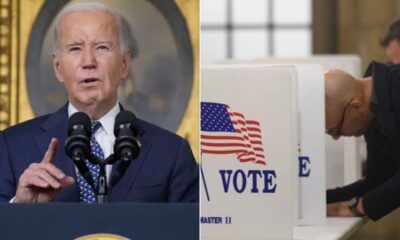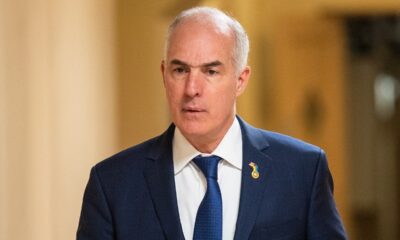This article was produced for ProPublica’s Local Reporting Network in partnership with the Idaho Statesman. Sign up for Dispatches to get stories like this one as soon as they are published.
Idaho
Idaho’s physician shortage is here. Here’s what we can do about it. – Idaho Capital Sun

I love living in Coeur d’Alene. I graduated from Lake City High School, and when it came time to start a family, my wife – born and raised in Coeur d’Alene – and I were intentional about doing so where we grew up.
I’ve known from a young age I wanted to pursue a career in health care and that passion caught flame within the halls of my hometown hospital, Kootenai Health. I have both received care at Kootenai Health (appendix removal as a teenager) and have provided care in a number of capacities. First, as a nursing assistant in the emergency department while an undergraduate student, then as a fourth-year Idaho WWAMI medical education student, and today as an internal medicine hospitalist and emergency medicine physician.
At Kootenai Health I also carry the title of regional medical director of virtual care and the transfer center. Overseeing the virtual care program means I ensure local and rural populations have access to services they desperately need such as psychiatry, infectious disease, cardiology and rheumatology. As medical director of the transfer center, I help ensure timely transfer of the region’s sickest patients and strengthen relationships with our rural partners.
From this vantage point, I see the strain the physician shortage has on Idaho’s health care system and, more importantly, Idaho residents, including my own friends and family. The physician shortage is not just a rural problem, but a state-wide problem and one we are experiencing in Kootenai County as well. It is complicated to address and requires a multi-prong approach to remedy. Two solutions where I see promise are investing in Idaho WWAMI medical education and a virtual care approach to medicine.
Idaho WWAMI medical education: A pathway to practicing in Idaho
Supported by the state Legislature for 51 years, Idaho WWAMI is an established partnership between the University of Idaho and the University of Washington School of Medicine. It allows Idaho residents to attend a world-class medical school in their home state for in-state tuition.
As an alum, I can attest to receiving superb medical training in a wide variety of medical settings: from small primary care clinics in Lewiston, Moscow and Plummer, to surgery at the Boise VA, to neurology and palliative care here at Kootenai Health. Through immersive training experiences and clerkships, Idaho WWAMI students gain exposure to medical care in rural settings. This is important because medical students who train in rural sites are twice as likely to practice medicine in rural areas. Even if Idaho WWAMI students end up practicing in Coeur d’Alene, their medical school education helps shape their sensitivity to patients who live in rural Idaho, as well as their colleagues who practice there.
Kootenai Health has been a clerkship site for Idaho WWAMI since 2005 and is also home to the only family medicine residency in North Idaho, which prepares physicians to work in rural or urban settings. Most of the residency graduates stay in Idaho (20 out of 36 graduates are practicing in-state), just like most Idaho WWAMI alum opt to practice in the Gem State (51%, which is well above the national average of 39%). WWAMI medical students train where they were raised and as a result have a higher rate of practicing here, too. I’m proof the Idaho WWAMI physician pathway works.
Virtues of virtual care
Despite Idaho WWAMI’s decades-long presence in the state, Idaho faces a physician shortage, recently made more acute by factors such as burnout and baby-boomer retirement. Kootenai Health providers have always traveled throughout northern Idaho for patient care, but in recent years the demand has grown exponentially as these communities continue to lose physicians.
When I first started at Kootenai Health in 2020, I regularly worked in Orofino, almost three hours away. Today, some of my colleagues travel on a weekly basis to clinics as far north as Bonners Ferry and as far south as Grangeville. Depending on road conditions, it can be dangerous to make these trips. The time it takes to drive could be better spent seeing more patients, who face hardships themselves when commuting to in-person appointments. An appointment that requires a patient to travel is compounded by factors like requesting time off of work, child care, transport and costs associated with overnight travel expenses.
This year, the Idaho Legislature passed House Bill 162, the Virtual Care Access Act, to address the ongoing needs of Idahoans through virtual care. I applaud the Legislature for this decision to ensure the residents of Idaho are able to receive access to needed care. Virtual care covers a wide variety of care delivery modalities, including live video visits between a provider and patient, as well as asynchronous opportunities like paperwork submission and chart reviews. There are stipulations in place to ensure that a doctor-patient relationship is established; where that is not the case, in-person appointments would be encouraged. I’ve seen firsthand how virtual care expedites physician-patient communication without sacrificing level of care.
Idaho WWAMI medical education trains students to care for the communities which raised them. Paired with advances in virtual care, our homegrown physicians can help address gaps our health care systems are grappling with. Including more timely diagnosis, specialized treatment, and perhaps most importantly, better outcomes and quality of life for Idahoans.
GET THE MORNING HEADLINES DELIVERED TO YOUR INBOX

Idaho
A Great Place in Idaho for a Sure Get Away

It doesn’t need to be far from home. Just away from home for a few days. Somewhere that I can buy or brew hot coffee. A shower is optional but would be great if I was staying beyond a couple of days. A Yeti cooler is preferred. An Igloo will do. Somewhere that wouldn’t require me to cook every meal. Something secure. I don’t want to be in a tent in the outback waiting to become the main course for a grizzly.
Credit Bill Colley.
A little civilization would be appreciated. Just don’t interrupt me when napping or reading. Unless you’re a woman between 18 and 65 years old.
A hotel room would be comfortable, but not required.
I’ve crunched some locations in my head. The backcountry is out. Even the hills south of Twin Falls are a little too isolated. There’s too much congestion in Salt Lake City or Boise. Yosemite National Park is too far away for a short break.
My thoughts have settled on somewhere like Pine, Idaho, and Anderson Ranch Reservoir. There are people around if you want some human contact. There are places to eat. If you want to drive into town for a few supplies, Fairfield is close.
It seems like just yesterday I made my last visit to the reservoir. It was Independence Day, 2020. During the COVID era. I recall I didn’t see anyone masked, or constantly wiping their hands with sanitizer.
A few months later, I spent an autumn week in Oregon. I couldn’t get my room cleaned, the restaurants were closed and everyone was afraid of being within six feet of a fellow human being. That’s the difference between a weekend at liberty and a week in a police state.
The 10 Worst Netflix Sci-Fi Movies
Sci-fi is where the gulf between good and bad is the widest, as it becomes obvious early on whether a movie is focused less on telling a good story than putting a bunch of digital effects and fight scenes onscreen.
Gallery Credit: Emma Stefansky
Idaho
After Decades, Voters Finally OK Replacement for Crumbling Idaho School

The Salmon School District in remote Central Idaho will finally get a new school.
After decades in which voters rejected every bond the district asked for, the community on Tuesday approved a $20 million bond to build a new pre-K-through-8 school with a resounding 72% support.
The election comes after the Idaho Statesman and ProPublica reported last year on how children across the state were learning in schools with freezing classrooms, leaking roofs and discolored water. Salmon was one of the most poignant examples — in the last two decades, the district failed to pass around a dozen bonds to replace its dilapidated schools. Idaho is one of just two states that require support from two-thirds of voters to pass a bond.
At Salmon’s Pioneer Elementary, the plumbing is failing, the floors are uneven and pose tripping hazards, and sewage sometimes backs up into a corner of the kitchen. Parts of the building aren’t accessible for students with disabilities. The foundation is crumbling.
Unable to pass a bond or to find other ways to fix these problems, the district turned to a state program created in 2006. It was one of only two districts ever to do so. But a state panel decided that Salmon’s problems — though bad enough to pose safety hazards — did not warrant a new school, only new roofs and seismic reinforcements. After that process, the district ultimately decided to close its middle school, which now sits abandoned beside the elementary school, surrounded by a razor-wire fence.
When the Statesman and ProPublica visited the elementary school last year, reporters saw many of the same problems the school had said it had about a decade ago, when it first applied for help from the state.
Over the past several months, a group called the Salmon Schools Needs Assessment Committee has been active on social media to provide information about the bond and share the challenges that the elementary school faces. In a Facebook post Wednesday, the committee said it was “overcome with gratitude and excitement.”
Jill Patton, the principal of the elementary school, said she is “deeply thankful” that the community came together to support the district’s schools. She praised the grassroots initiative spearheaded by the assessment committee.
The effort “involved a remarkable group that dedicated countless hours to understanding community concerns and identifying preferred solutions,” she said in an email. “They meticulously developed a plan that the community could rally behind.”
Since 2006, the news organizations reported, fewer than half of all Idaho school bonds have passed, but that 80% of them would have passed if a simple majority were required.
Idaho lawmakers considered a proposal that would have started the process to lower the vote threshold needed to pass a school bond, but the effort did not move forward during the legislative session.
Legislators did approve $2 billion in funding over a decade to repair and replace schools. The measure was signed by Republican Gov. Brad Little, who cited the investigation and called school funding “priority No. 1” in his State of the State address in January.
Idaho
Election 2024: Biden wins Idaho Democratic Party’s presidential caucus • Idaho Capital Sun

President Joe Biden cruised to victory in Thursday’s Idaho Democratic Caucus, claiming 95% of the votes to win the six-candidate caucus outright, the Idaho Democratic Party announced.
Results released late Thursday night by the Idaho Democratic Party showed Biden won more votes than all the other candidates combined.
- Biden: 2,297 votes, 95%
- David Olscamp: 14 votes, 0.5%
- Jason Palmer: five votes, 0.2%
- Armando Perez-Serrato: three votes, 0.1%
- Dean Phillips: 14 votes, 0.5%
- Marianne Williamson: 79 votes, 3.28%
The Idaho Democratic Party reported there were 2,412 votes cast in Thursday’s caucus.
A total of 2,412 votes means turnout was exceedingly low on Thursday. However, calculating the percentage of voter turnout could be tricky because Democrats and unaffiliated voters were allowed to vote in the caucus.
The Idaho Secretary of State’s Office reports there are 125,585 registered Democratic voters in the state. Based only on the pool of 125,585 Democratic voters, turnout could be calculated at about 1.9%, but that calculation would ignore the fact that some unaffiliated voters did vote in the Democratic caucus. The Democratic Party did not indicate the number of unaffiliated voters who cast ballots Thursday.
Across the Gem State, there are 273,862 unaffiliated voters, according to the Idaho Secretary of State’s Office.
GET THE MORNING HEADLINES DELIVERED TO YOUR INBOX
At any rate, Biden’s victory was never in doubt. As the incumbent president, Biden had already secured enough delegates to clinch the Democratic Party’s nomination for president.
The presidential caucus is new for Idaho voters this year because the Idaho Legislature seemingly unintentionally eliminated the presidential primary election in Idaho by passing House Bill 138 during the 2023 legislative session. The Idaho Republican Party held its presidential caucus on March 2. The Idaho Republican Party announced that former President Donald J. Trump won Idaho’s GOP caucus.
Voters, officials say they prefer a primary election rather than a presidential caucus
Several Democratic caucus goers and elected officials told the Idaho Capital Sun that they would prefer to vote for president in a primary election instead of a separate caucus.
Need to get in touch?
Have a news tip?
“It seems pretty easy, but I don’t know why we have primaries and a caucus,” voter Sally Davies-Sexton told the Idaho Capital Sun after casting her vote for Biden at the Timberline High School caucus site in Boise on Thursday. “It’s just having two events, and then this is not exactly around the corner.”
Idaho’s primary election, which did not feature presidential candidates, took place earlier in the week on Tuesday.
Voter Mary Ruckh has volunteered as a poll worker and served as a chief elections judge at a polling site during Tuesday’s Idaho primary election. Ruckh rode her bicycle to the Timberline High School caucus site to vote for Biden, but said she would have preferred to vote in a primary election. Primary elections are run by county elections offices and the state, while a caucus is run by the political parties.
“A primary – it’s so much more structured, it’s under the egis of government,” Ruckh said.
Ruckh did say this year’s Democratic presidential caucus was a major improvement over the most recent Democratic caucus in 2016, which was marred by long lines that many voters endured for hours.
Idaho House Minority Leader Ilana Rubel, D-Boise, told the Sun on Thursday that the Idaho Legislature needs to reinstate a presidential primary.

“We very much wanted a primary, because we were really concerned about the limitations on a caucus and whether that would restrict full participation,” Rubel said.
“I certainly hope before the next presidential race that we are able to restore a primary,” Rubel added.
Idaho Democratic Party rules allowed voters who will turn 18 years old by the Nov. 5 general election to register to vote and vote in Thursday’s presidential caucus.
Kennedy Fletcher, a 17-year-old first-time voter, received a round of applause from Democratic volunteers and other voters when she turned in her ballot Thursday night at Timberline High School. Fletcher told the Sun she is supporting Biden because of the clear differences between him and Trump.
“I like getting involved politically. I know who I am going to vote for and everything, and I am really excited to vote in the actual presidential election,” Fletcher said.

Idaho Democratic Party Chair Lauren Necochea, who is also the outgoing House assistant minority leader, said she wasn’t surprised to see Biden perform strongly in Thursday’s caucus. Necochea said the party will unify strongly behind Biden heading into the Nov. 5 Election Day.
“President Biden is the only person who has beaten President Trump in a presidential election,” Necochea said.
Idaho Democrats allowed absentee voting, media coverage
While the Idaho Republican Party’s March 2 caucus required voters to participate only in person, the Idaho Democratic Party allowed voters request and mail in an absentee ballot if they were unable to attend due to military or religious service, work, disability, illness, child care obligations or the inability to travel.
The Idaho Democratic Party also allowed news reporters to observe the caucus and interview voters. The Idaho Republican Party did not allow news reporters who are not affiliated with the Republican Party to observe its caucus.
-

 Politics1 week ago
Politics1 week agoVulnerable Dem incumbents move to the center in key swing states as Biden panders to far-left base
-

 World1 week ago
World1 week ago‘Monstrous crime’: World reacts to attack on Slovakia’s prime minister
-

 News1 week ago
News1 week agoHow a migrant aid group got caught up in a right-wing social media thread : Consider This from NPR
-

 Politics1 week ago
Politics1 week agoSouthern border migrant encounters decrease slightly but gotaways still surge under Biden
-

 Politics1 week ago
Politics1 week agoDem newcomer aims for history with primary win over wealthy controversial congressman
-

 World1 week ago
World1 week agoSlovakia PM Robert Fico in ‘very serious’ condition after being shot
-

 World1 week ago
World1 week agoCanadian Nobel-winning author Alice Munro dies aged 92
-

 Movie Reviews1 week ago
Movie Reviews1 week agoIs Coppola’s $120M ‘Megalopolis’ ‘bafflingly shallow’ or ‘remarkably sincere’? Critics can’t tell



















